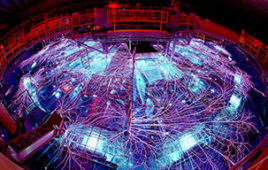
Illustration of nanosized device made of two joined silver single crystals that generate light by inelastical electron tunneling. Credit: Steven Bopp, University of California – San Diego
Researchers from the University of California San Diego have used advanced fabrication techniques to build a nanosized device out of silver crystals that is able to generate light by efficiently tunneling electrons through a small barrier.
The new insight could bring researchers one-step closer to realizing ultra-compact light sources for high speed, optical data processing and other on-chip applications.
The new device emits light using a phenomenon called inelastic electron tunneling where electrons move through a solid barrier that they cannot classically cross. The electrons lose some of their energy while crossing, creating either photons or phonons in the process.
Plasmonic researchers have attempted to use inelastic electron tunneling to develop extremely small light sources with large modulation bandwidth in the past. However, because only a tiny fraction of electrons can tunnel inelastically, the efficiency of light emission is typically very low—only a few hundredths of a percent, at most.
In the new study, the researchers developed a device that improves the efficiency to approximately 2 percent, which despite not being high enough for practical use, is a step towards a new type of light source.
“We’re exploring a new way to generate light,” Zhaowei Liu, a professor of electrical and computer engineering at the UC San Diego Jacobs School of Engineering, said in a statement.
The team used computational methods and numerical simulations to design the light emitting device. They then constructed the device using advanced solution-based chemistry techniques.
The device has a bow-tie shaped plasmonic nanostructure consisting of two cuboid, single crystals of silver joined at one corner. A 1.5-nanometer-wide barrier of insulator made of a polymer called polyvinylpyrrolidone (PVP) connects the corners.
The metal-insulator-metal junction is where electrodes connected to the nanocrystals allow voltage to be applied to the device. As electrons tunnel from a corner of a silver nanocrystal through the PVP barrier, they transfer energy to surface plason polaritons—electromagnetic waves that travel along the metal-insulator interface. The energy is then converted to photons.
The team created a high quality optical antenna with a high local density of optical states by joining two silver single crystals together at their corners with a miniscule barrier of insulator in between. This results in a more efficient conversion of electronic energy to light.
Metal-insulator-metal junctions often have featured a low light emission efficiency due to being constructed by joining metal crystals along an entire face, as opposed to a corner.
Giving electrons a high quality optical antenna with a much smaller gap to tunnel through allows efficient light emission, and this kind of structure has been difficult to fabricate with nanolithography methods used in the past.
“Using chemistry, we can build these precise nanosized junctions that allow more efficient light emission,” Andrea Tao, a professor of nanoengineering at the UC San Diego Jacobs School of Engineering, said in a statement. “The fabrication techniques we use give us atomic level control of our materials—we can dictate the size and shape of crystals in solution based on the reagents we use, and we can create structures that have atomically flat faces and extremely sharp corners.”
The researcher’s next plan to boost the efficiency another order of magnitude higher. They are also exploring different geometries and materials for future studies.
The study was published in Nature Photonics.




